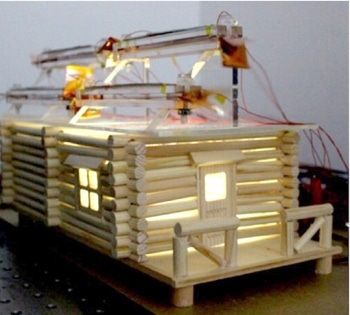May 27 2016
“Smarter” cities can be made from the “Internet of Things” (IoT) by linking a widespread network of small communications devices to make life easier and more efficient. However, every one of these machines would need a large amount of energy.
 Hybrid solar and wind harvesting cells on the top of this model house collect enough energy to light it up inside. (Credit- American Chemical Society)
Hybrid solar and wind harvesting cells on the top of this model house collect enough energy to light it up inside. (Credit- American Chemical Society)
Instead of adding to the global dependence on fossil fuels to drive the network, scientists claim that they have discovered a novel solution. The results of their study performed on a wind and solar energy-harvesting device has been published in the ACS Nano journal.
According to news reports, computer industry specialists estimate that tens of billions of devices will constitute the IoT in just five years. They will be installed in homes, syncing alarm clocks to coffee makers; they will be in buildings, controlling air temperature and lights. However they will also need plenty of energy to run. However, it is rather difficult to sustainably produce energy in cities near to where the devices would be used. For instance, cities do not have a great deal of space for tall wind turbines. Zhong Lin Wang, Ya Yang, and co-workers wanted to develop a better method to power smart cities.
To meet this objective, the scientists incorporated two energy harvesting technologies in a single device: a nanogenerator, which could change wind energy to electrical output, and a silicon solar cell. The system’s solar cell constituent provides 8 mW of power output (1 mW can illuminate up 100 small LEDs), while up to 26 mW is delivered by the wind harvesting constituent. Jointly, under simulated wind and sun conditions, four machines installed on a model home roof can turn on the LEDs within and power a temperature-humidity sensor. Set up in great numbers on actual rooftops, this hybrid device could help to realize smart cities.
The study was funded by the Beijing Natural Science Foundation, the National Natural Science Foundation of China, External Cooperation Program of BIC, the Chinese Academy of Sciences, the 2015 Annual Beijing Talents Fund and China’s Thousand Talents Program.